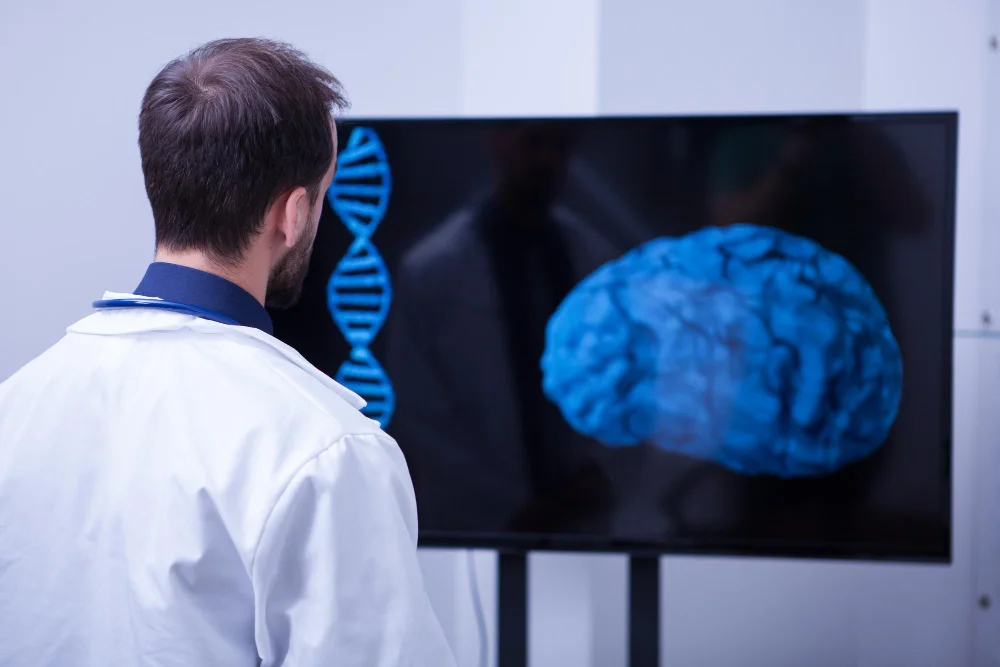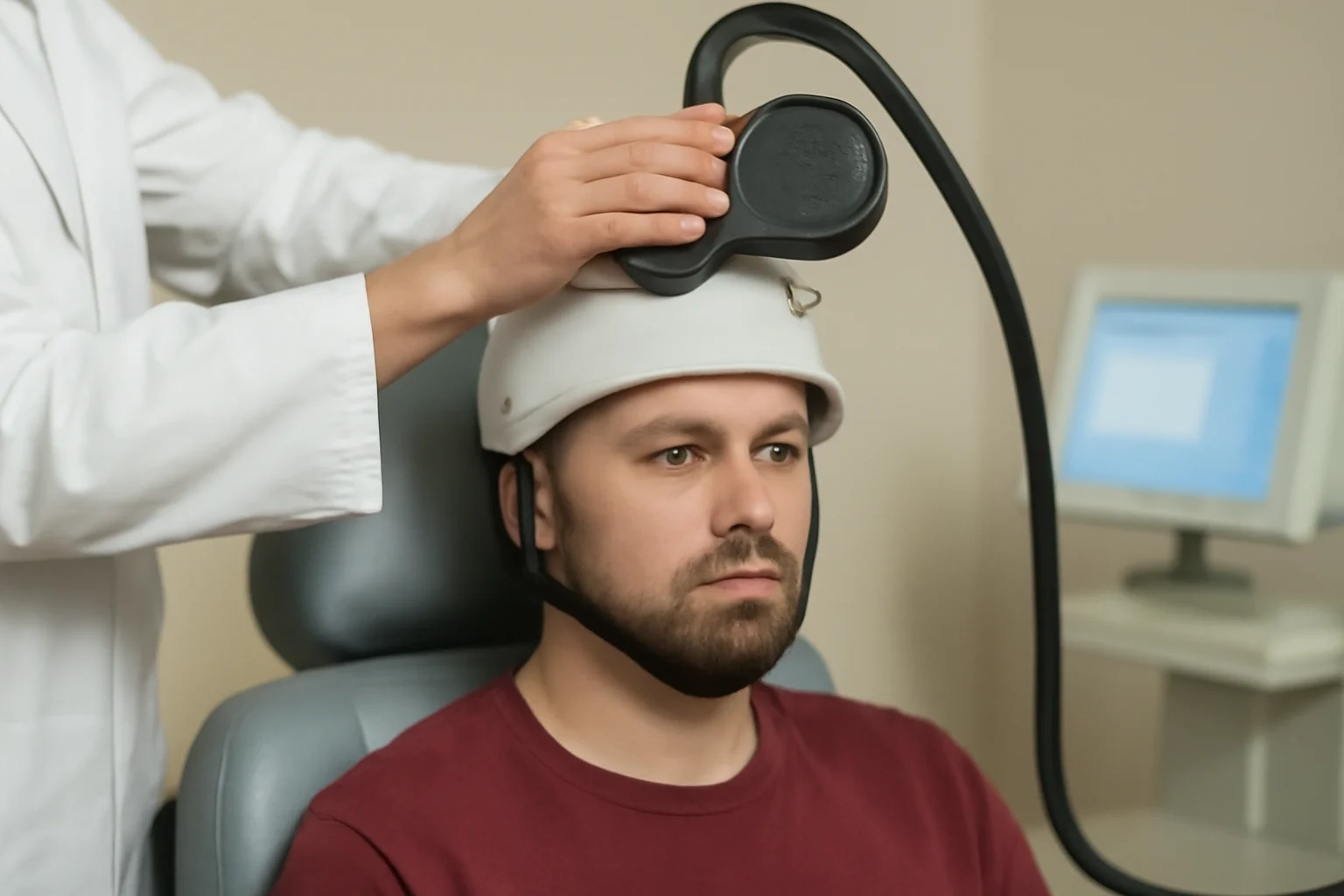Obsessive-Compulsive Disorder (OCD) affects millions of people worldwide, causing intrusive thoughts and repetitive behaviors that significantly impair daily functioning. While traditional treatments help many individuals, approximately 40-60% of people with OCD don’t respond adequately to first-line therapies.
For these individuals, Deep Transcranial Magnetic Stimulation (Deep TMS) offers new hope. This article explores deep TMS for OCD, how it works, its benefits, and why it’s considered a promising treatment option for individuals with treatment-resistant OCD.
Finding effective treatments for OCD is critical, especially for individuals who don’t respond well to traditional therapies such as medications and cognitive behavioral therapy (CBT). When standard treatments fail, people continue suffering from obsessions and compulsions that control their lives. Deep TMS for OCD represents an innovative approach that targets the neurological basis of the disorder.
What is Deep TMS for OCD?
Deep TMS for OCD is an FDA-approved, non-invasive treatment that uses magnetic fields to stimulate specific areas of the brain involved in OCD symptoms. Unlike standard TMS, which affects only surface brain regions, Deep TMS reaches deeper brain structures that play a role in obsessive-compulsive behaviors.
The treatment uses a specialized helmet-like device called the H-coil, which generates magnetic pulses that penetrate up to 4 centimeters into the brain. This deeper reach allows the treatment to target brain circuits that traditional TMS can’t effectively access.
How Deep TMS Works for OCD
The Mechanism of Action
Deep TMS works by modulating neural activity in brain regions associated with OCD. The magnetic pulses pass through the skull and induce electrical currents in targeted brain tissue. These currents affect neuron firing patterns, helping to restore normal brain function in areas that have become dysregulated in OCD.
The treatment influences neurotransmitter systems, particularly those involving serotonin, dopamine, and glutamate—all of which play roles in OCD. By repeatedly stimulating specific brain circuits over multiple sessions, deep TMS OCD treatment creates lasting changes in neural connectivity and activity patterns.
Targeted Brain Regions in OCD Treatment
Research has identified several brain regions involved in OCD, including the orbitofrontal cortex, anterior cingulate cortex, and striatum. Deep TMS for OCD primarily targets the medial prefrontal cortex and anterior cingulate cortex—regions involved in error detection, conflict monitoring, and response inhibition.
The deeper penetration of dTMS for OCD allows it to reach these critical brain structures more effectively than standard TMS. This targeting precision is key to the treatment’s effectiveness in reducing OCD symptoms.

Benefits of Deep TMS for OCD
Non-Invasive Treatment Option
One of the primary advantages of deep TMS for OCD is its non-invasive nature. Unlike deep brain stimulation, which requires surgery to implant electrodes, Deep TMS works entirely from outside the body. There are no incisions, no implanted devices, and no recovery period needed after each session.
This non-invasive approach makes the treatment accessible to a broader range of patients, including those who can’t undergo surgery due to medical conditions or personal preferences.
Minimal Side Effects
Deep TMS for OCD produces significantly fewer side effects than medications commonly prescribed for OCD. While SSRIs can cause weight gain, sexual dysfunction, drowsiness, or nausea, Deep TMS side effects are typically mild and temporary.
The most common side effects include:
- Mild headache during or after treatment (affects about 30-40% of patients)
- Scalp discomfort at the treatment site
- Facial muscle twitching during the procedure
- Brief lightheadedness immediately after treatment
These side effects usually diminish after the first few sessions. Serious side effects are rare, with seizure risk at less than 0.1%.
Long-Term Effectiveness
Studies show that the benefits of deep TMS OCD treatment can persist long after the initial treatment course ends. Many patients maintain symptom improvement for months or even years. Unlike medications that only work while you’re taking them, Deep TMS creates lasting changes in brain function.
Clinical Evidence: Does Deep TMS Work for OCD?
Clinical trials demonstrate that dTMS for OCD significantly reduces symptom severity. In FDA approval studies, approximately 38% of patients achieved clinical response (at least 30% reduction in symptoms), and about 10-15% achieved full remission of OCD symptoms.
While these numbers might seem modest, they’re impressive for a population that has already failed multiple other treatments. Research published in the American Journal of Psychiatry found that Deep TMS produced clinically meaningful improvements that persisted for at least a month after treatment completion.
Patient-reported outcomes indicate improvements not just in symptom severity but also in quality of life, daily functioning, and overall well-being. Many people report being able to return to work, improve relationships, and engage in activities that OCD had previously prevented.
Deep TMS vs Traditional OCD Treatments
Comparison with Medication for OCD
SSRIs like fluoxetine, sertraline, and fluvoxamine are first-line medications for OCD. They help about 40-60% of patients but often require high doses and can take 10-12 weeks to show full effects. Side effects commonly cause people to discontinue medication.
Deep TMS for OCD offers several advantages over medication. It works faster, with many patients noticing improvements within 2-4 weeks. It produces minimal systemic side effects. And it may work for people who haven’t responded to multiple medication trials.
However, medications are more convenient—taking a daily pill is easier than attending daily treatment sessions for weeks. For many people, combining Deep TMS with medication produces better results than either treatment alone.
Deep TMS vs Cognitive Behavioral Therapy (CBT)
Exposure and Response Prevention (ERP), a type of CBT, is highly effective for OCD, with response rates of 60-70% among those who complete treatment. ERP involves gradually exposing yourself to feared situations while resisting compulsive behaviors—a process that can be extremely challenging.
Deep TMS for OCD doesn’t replace therapy, but can make therapy more effective. When Deep TMS reduces symptom severity, patients often find ERP exercises more manageable. Some people who couldn’t tolerate ERP due to severe symptoms find that Deep TMS reduces their symptoms enough to make therapy feasible.
Deep TMS vs Electroconvulsive Therapy (ECT)
ECT is occasionally used for severe, treatment-resistant OCD, but it requires general anesthesia, intentionally induces seizures, and can cause memory loss. Most people understandably prefer to avoid ECT if other options exist.
Deep TMS OCD treatment offers a much gentler alternative. It requires no anesthesia, causes no memory problems, and carries far fewer risks than ECT.
How to Get Started with Deep TMS for OCD
Finding a Provider for Deep TMS Therapy
Start by searching for TMS centers in your area that specifically offer Deep TMS using the H-coil system. Not all TMS facilities have Deep TMS equipment, so verify this before scheduling appointments. The manufacturer’s website (Brainsway) maintains a provider directory of certified Deep TMS centers.
Check that providers are properly certified and experienced in treating OCD specifically. Some TMS centers focus primarily on depression and may have less experience with OCD protocols.
Initial Evaluation and Treatment Planning
Your first appointment involves a comprehensive evaluation to determine if you’re a good candidate for deep TMS for OCD. The provider will review your OCD history, previous treatments you’ve tried, current medications, and medical history.
You’ll need to meet certain criteria for treatment, including:
- Diagnosis of OCD confirmed by a mental health professional
- Insufficient response to at least one previous treatment
- No contraindications like metal implants in the head or a history of seizures
The provider will use standardized assessments like the Yale-Brown Obsessive Compulsive Scale (Y-BOCS) to measure your baseline symptom severity and track progress throughout treatment.
What to Expect During Treatment
On your first treatment day, the technician will determine the optimal stimulation intensity for your brain by finding your motor threshold. This personalized calibration ensures safe and effective treatment.
During each session, you’ll sit in a comfortable chair wearing the H-coil device. The treatment involves rhythmic magnetic pulses that create a tapping sensation and clicking sounds. You’ll wear earplugs to protect your hearing.
Most people tolerate treatment well and can read, listen to music, or simply relax during sessions. After each 20-30 minute treatment, you can immediately resume normal activities.
Progress typically becomes noticeable after 2-4 weeks of daily treatment, with continued improvement throughout the 4-6 week course. Your provider will reassess your symptoms regularly to track your response.

A Valuable Tool for OCD Management
Deep TMS for OCD represents a significant advancement in treating this challenging condition. For people who haven’t found relief from traditional therapies, it offers new hope through a non-invasive, evidence-based approach that targets the neurological roots of OCD.
While not a cure-all, deep TMS for OCD can be a valuable part of a comprehensive treatment plan that may also include medication, therapy, and lifestyle modifications. The treatment’s minimal side effects, non-invasive nature, and lasting benefits make it an appealing option for many individuals struggling with treatment-resistant OCD.
